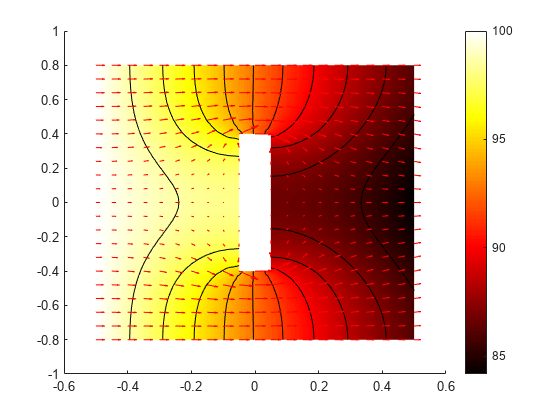Heat Transfer in Block with Cavity
This example shows how to solve for the heat distribution in a block with cavity.
Consider a block containing a rectangular crack or cavity. The left side of the block is heated to 100 degrees centigrade. At the right side of the block, heat flows from the block to the surrounding air at a constant rate, for example . All the other boundaries are insulated. The temperature in the block at the starting time is 0 degrees. The goal is to model the heat distribution during the first five seconds.
Create Thermal Analysis Model
The first step in solving a heat transfer problem is to create a thermal analysis model. This is a container that holds the geometry, thermal material properties, internal heat sources, temperature on the boundaries, heat fluxes through the boundaries, mesh, and initial conditions.
thermalmodel = createpde("thermal","transient");
Import Geometry
Add the block geometry to the thermal model by using the geometryFromEdges function. The geometry description file for this problem is called crackg.m.
geometryFromEdges(thermalmodel,@crackg);
Plot the geometry, displaying edge labels.
pdegplot(thermalmodel,"EdgeLabels","on") ylim([-1,1]) axis equal

Specify Thermal Properties of Material
Specify the thermal conductivity, mass density, and specific heat of the material.
thermalProperties(thermalmodel,"ThermalConductivity",1,... "MassDensity",1,... "SpecificHeat",1);
Apply Boundary Conditions
Specify the temperature on the left edge as 100, and constant heat flow to the exterior through the right edge as -10. The toolbox uses the default insulating boundary condition for all other boundaries.
thermalBC(thermalmodel,"Edge",6,"Temperature",100); thermalBC(thermalmodel,"Edge",1,"HeatFlux",-10);
Set Initial Conditions
Set an initial value of 0 for the temperature.
thermalIC(thermalmodel,0);
Generate Mesh
Create and plot a mesh.
generateMesh(thermalmodel);
figure
pdemesh(thermalmodel)
title("Mesh with Quadratic Triangular Elements")
Specify Solution Times
Set solution times to be 0 to 5 seconds in steps of 1/2.
tlist = 0:0.5:5;
Calculate Solution
Use the solve function to calculate the solution.
thermalresults = solve(thermalmodel,tlist)
thermalresults =
TransientThermalResults with properties:
Temperature: [1308x11 double]
SolutionTimes: [0 0.5000 1 1.5000 2 2.5000 3 3.5000 4 4.5000 5]
XGradients: [1308x11 double]
YGradients: [1308x11 double]
ZGradients: []
Mesh: [1x1 FEMesh]
Evaluate Heat Flux
Compute the heat flux density.
[qx,qy] = evaluateHeatFlux(thermalresults);
Plot Temperature Distribution and Heat Flux
Plot the solution at the final time step, t = 5.0 seconds, with isothermal lines using a contour plot, and plot the heat flux vector field using arrows.
pdeplot(thermalmodel,"XYData",thermalresults.Temperature(:,end), ... "Contour","on",... "FlowData",[qx(:,end),qy(:,end)], ... "ColorMap","hot")

